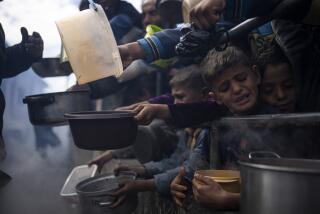In Syria, no letup in fighting as Ramadan begins
As the Muslim holy month of Ramadan began Wednesday in Syria, civilians in parts of Aleppo, Homs and the Damascus suburbs remained cut off from food and aid supplies as government and rebel forces tried to besiege each other into submission.
Ahmad Jarba, the newly elected president of the opposition Syrian National Coalition, this week suggested a cease-fire for the fasting month, but nothing came of the offer.
Government forces bombarded several opposition-held neighborhoods in Homs, including hard-hit Khaldiyeh and Bab Houd, meeting resistance from rebels, according to the London-based pro-opposition group Syrian Observatory for Human Rights.
INSIDE SYRIA: More Times coverage
The United Nations human rights agency last week said it was “extremely concerned” about up to 4,000 civilians trapped by the fighting in Homs, part of a government offensive to try and retake more than a dozen rebel-held neighborhoods that has been ongoing for two weeks. They face severe shortages of food, water, medicine, electricity and fuel amid a siege that began more than a year ago, according to the U.N. Office of the High Commissioner of Human Rights.
Russia, a key ally of Syrian President Bashar Assad, last week blocked approval of a statement by the U.N. Security Council expressing “grave concern” about the situation in Homs and calling on the government to allow immediate and unhindered access to humanitarian workers seeking to bring aid and medical care to those trapped there.
U.N. agencies recently reported that Syria’s food security had “significantly” deteriorated, with 4 million people unable to produce or buy enough to eat.
Abu Jabir, an opposition activist in Homs who asked to be identified by a traditional nickname, said the targeted neighborhoods were subject to constant heavy shelling as government forces backed by fighters from the Lebanese militant group Hezbollah tried to regain full control. He said some residents in the hardest-hit neighborhood of Khaldiyeh had been able to get out Tuesday with the help of the rebel Free Syrian Army, but others remained trapped.
In Aleppo, government-controlled areas have been suffering from food shortages for the last week as rebels attempt to take control of the northern city.
Clashes on the edges of Aleppo and rebel checkpoints have prevented food supplies from the suburbs reaching the city. The blockade was partially lifted Wednesday afternoon when rebels opened the only crossing linking government- and opposition-controlled areas, but it was unclear how long the opening would last.
Residents in opposition-held neighborhoods had protested the closure of the crossing by rebels. A video posted on YouTube purportedly showed one recent demonstration being dispersed with gunfire [see above]. The authenticity of the footage could not be independently verified.
“No shops are open, no vegetables, no meat, no milk,” said a woman reached Tuesday in the besieged neighborhood of New Aleppo, who did not want her name published for fear of rebel reprisals. “The vegetable sellers have all put their crates on top of one another and gone home. All that is left is canned food, like tuna and foul [beans].”
She was told that several neighborhood residents were able to drive through opposition checkpoints Tuesday and reach the city’s suburbs, where they stocked up on fruit and vegetables. But, she said, upon their return they were stopped by fighters from Al Nusra Front, an Al Qaeda affiliate, and killed for trying to bring food into the area.
“We have to starve until we are with them,” she said of the opposition. “Because in what they call ‘liberated areas,’ everything is available.”
“People were hopeful that in Ramadan things would be better,” she continued. “But with Ramadan has come the worst situation.”
ALSO:
Ramadan holiday adds to Egypt’s anxieties
Israel holding Palestinian who disappeared in Egypt
Edward Snowden would be valuable pawn for Venezuela
More to Read
Sign up for Essential California
The most important California stories and recommendations in your inbox every morning.
You may occasionally receive promotional content from the Los Angeles Times.











